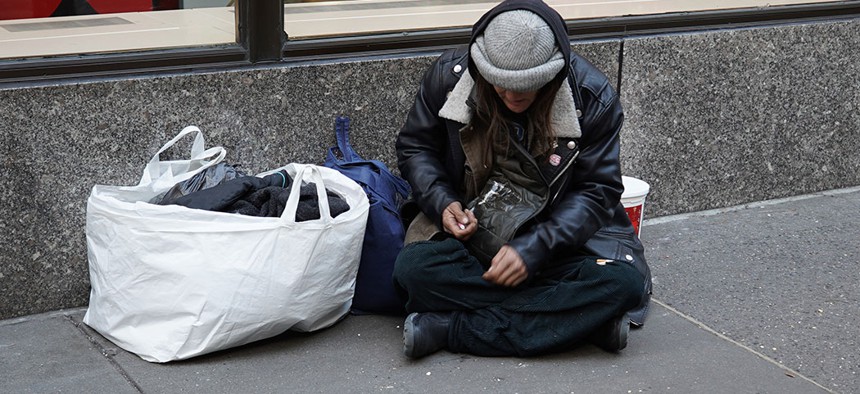New York City
Time for a second Cuomo commission on homelessness
New York City needs a comprehensive review of its approach to housing the homeless.

In New York City, the annual budget for homelessness tops $3 billion, yet 62,000 homeless people are overwhelming the municipal shelter system. Leonard Zhukovsky/Shutterstock
In 1991, 22,000 people in New York City were homeless, two-thirds of them families with children, and it was overwhelming the municipal shelter system. Several thousand childless adults, many suffering from mental illness or other serious health issues, were sleeping in train stations and other public spaces. To address this ongoing social and human tragedy, a succession of mayors had advanced well-meaning but ultimately ineffective policy responses.
In New York City today, the annual budget for homelessness tops $3 billion, yet 62,000 homeless people, two-thirds of them families with children, are overwhelming the municipal shelter system. Several thousand childless adults, many suffering from mental illness or other serious health issues, are sleeping in train stations and other public spaces. To address this ongoing social and human tragedy, a succession of mayors has advanced well-meaning but ultimately ineffective policy responses.
If you were living in the city in 1991, it feels like you’ve seen this film before. That’s why New York City should follow then-Mayor David Dinkins’ approach of comprehensively reviewing the city’s homelessness policies and integrating them into a coherent strategy.
Since 1991, vastly increasing the city’s spending on homeless services has accomplished little more than keeping the increase in the number of homeless people under 200%. But a closer look at history offers a positive lesson for today’s policymakers.
Back in 1991, under growing pressure to address street homelessness and a failing public shelter system, Dinkins ventured out of his progressive comfort zone to appoint an ambitious young transitional housing expert to lead an independent Commission on Homelessness.
That expert was Andrew Cuomo, and the landmark report he crafted, “The Way Home: A New Direction in Social Policy,” transformed how governments everywhere understood the multifaceted problem of homelessness.
Rejecting the “superficiality” of policymaking driven by politics and ideology, the commission leveraged facts and data analysis to craft actionable recommendations that rejected the traditional zero-sum choice between providing more housing or more services. Specifically, in addition to new affordable housing and rental subsidies, Cuomo called for the creation of an “intelligent continuum of care” that included homelessness prevention services, more effective assessment of individual client needs, closing the city’s notoriously dangerous emergency large-group shelters, and creating nonprofit-run “transitional shelters” with programming to “end dependency” and promote “self-sufficiency and independence.”
Adopted in the main, Cuomo’s recommendations formed the basis of a coherent, bipartisan and arguably successful homelessness policy consensus for the next decade. Correlation is not causation, but it’s worth noting that the number of homeless people in New York City shelters largely stabilized in the 10 years after 1991.
Sadly, policymaking driven by politics and ideology is now back in style. On Dec. 17, New York City Mayor Bill de Blasio announced his third major initiative in four years to fight homelessness, this time a $100 million plan to end “street homelessness” within five years by adding 1,000 beds in “safe haven” facilities and converting existing buildings to create 1,000 apartments.
Despite its more of the same incrementalism, de Blasio assures us that this is “a plan to end homelessness in New York City as we know it, once and for all.” Too bad we’ll have to wait three years after his term expires to see how it turns out.
Not to be outdone, the City Council recently adopted legislation that will force housing developers who receive city financial assistance to set aside 15% of units in large new rental buildings for the homeless. Some affordable housing experts worry that such inflexible requirements will constrain new affordable housing development and destabilize fragile communities.
If these recent policy initiatives strike you as incremental, reactive, and driven by politics and ideology, perhaps it’s because they lack coherence as the product of serious research and data analysis.
That’s why it’s time for a Cuomo Commission 2.0. This doesn’t necessarily mean the city should return to policies of the 1990s. The complex challenge of homelessness has changed in the past three decades. Instead, we should remember that the key to the original commission’s remarkable impact was that Cuomo and his colleagues rose above politics and ideology to focus on the hard work of forging an enduring, evidence-based consensus. After almost 30 years, perhaps we’re ready to try that approach again.
NEXT STORY: City & State’s best op-eds in 2019

